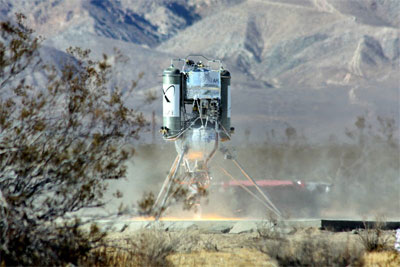 High Drama in the Mojave. From MSNBC :
High Drama in the Mojave. From MSNBC : The contest reached its climax on Friday, when Masten's Xoie rocket made its million-dollar flight. "The drama has just been unbelievable," Stuart Witt, general manager of the Mojave Air and Space Port, told me when it was over.So private enterprise has not one, but two capable proof-of-principle demonstrators for the technology for Lunar landing. And all for the cost to the US Taxpayer of less than $2 million.
The rules for the Lunar Lander Challenge's Level 2 contest required rocketeers to guide their remote-controlled craft through a complete round trip between one launch pad and a different boulder-strewn pad more than 50 meters (164 feet) away. Each leg of the flight had to last at least 180 seconds, and the rocket had to rise at least 50 meters above the ground. All this had to be done before time ran out on a 135-minute period.
Friday's launch came after days of ups and downs: Communication glitches twice ruled out launch attempts on Wednesday, and a fire that broke out on the launch vehicle spoiled the Xoie rocket's maiden flight on Thursday. The blaze was quickly put out, but not quickly enough to avoid doing damage to Xoie. That damage meant Xoie couldn't get all the way through the required course.
On Thursday night, the Lunar Lander Challenge judges said they would let the Masten team make repairs to the rocket overnight and give them one more chance to fly. The team worked all night to get Xoie back in shape.
...
The program, one of NASA's Centennial Challenges, was aimed at encouraging the development of new rocket technologies that could potentially be used in future spacecraft. The kind of power required to win the contest would also be enough for a lunar landing and ascent. But the current contestants don't expect to provide NASA with honest-to-goodness lunar landers anytime soon. Rather, they see the prize as an extra incentive to build vehicles capable of taking up suborbital space tourists, or putting small payloads into orbit.
...
Scorpius' average landing accuracy on Sept. 12 was about 34 inches (86 centimeters). The unofficial figures for Xoie were around 11 inches (28 centimeters) for the first leg of the round trip, and 4 inches (10 centimeters) for the second. The resulting average of 7.5 inches (19 centimeters) was enough to move Xoie ahead of Scorpius.
While the significance of a "proof-of-principle" prototype should not be over-estimated, and costs of a production model (even for cargo) would be many hundreds of times greater... it's still a small fraction of what it would have taken NASA to achieve. A very small fraction.
It's beginning to look like the relatively simple problems in Rocket Science are best solved by this philosophy. Certainly it should be tried. Scaling it up to hard problems, like high-capacity boosters is another matter, but there's lots of such (relatively) easy problems as this one which will require solution for us to go into space - and stay there. And it looks like we can solve them for 1% of the money that we thought it would cost.

3 comments:
Does it run under DOS?
Radar Girl!
*HUG*
I am sure they will find something to spend the other 99% on.
Post a Comment